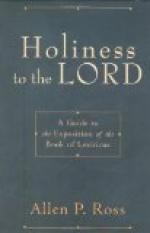This was only one of the difficulties which had to be overcome. The eyes are set on the pre-fulcral lever of the head. For our safety we must be able to look in all directions—over this shoulder or that. We must also be able to turn our heads so that our ears may discover in which direction a sound is reaching us. In fashioning a fulcral joint for the head, then, two different objects had to be secured: free mobility for the head, and a safe transit for the medullary part of the brain stem. How well these objects have been attained is known to all of us, for we can move our heads in the freest manner and suffer no damage whatsoever. Indeed, so strong and perfect is the joint that damage to it is one of the most uncommon accidents of life.
Let us see, then, how this triumph in engineering has been secured. In her inventive moods Nature always hits on the simplest plan possible. In this case she adopted a ball-and-socket joint—the kind by which older astronomers mounted their telescopes. By such a joint the telescope becomes, just as the head is, a lever of the first order. The eyeglass is placed at one end of the lever, while the object-glass, which can be swept across the face of the heavens, is placed at the other or more distant end. In the human body the first vertebra of the backbone—the atlas—is trimmed to form a socket, while an adjacent part of the base of the skull is shaped to play the part of ball. The kind of joint to be used having been hit upon, the next point was to secure a safe passage for the brain stem. That, too, was worked out in the simplest fashion. The central parts of both ball and socket were cut away, or, to state the matter more exactly, were never formed. Thus a passage was obtained right through the centre of the fulcral joint of the head. The centre of the joint was selected because when a lever is set in motion the part at the fulcrum moves least, and the medulla, being placed at that point, is least exposed to disturbance when we bend our heads backwards, forwards, or from side to side. When we examine the base of the skull, all that we see of the ball of the joint are two knuckles of bone (Fig. 3, A), covered by smooth slippery cartilage or gristle, to which anatomists give the name of occipital condyles. If we were to try to complete the ball, of which they form a part, we should close up the great opening—the foramen magnum—which provides a passageway for the brain stem on its way to the spinal canal. All that is to be seen of the socket or cup is two hollows on the upper surface of the atlas into which the occipital condyles fit (Fig. 3, B). Merely two parts of the brim of the cup have been preserved to provide a socket for the condyles or ball.
[Illustration: Fig. 3.—A, The opening in the base of the skull, by which the brain stem passes to the spinal canal. The two occipital condyles represent part of the ball which fits into the cup formed by the atlas. B, The parts of the socket on the ring of the atlas.]




